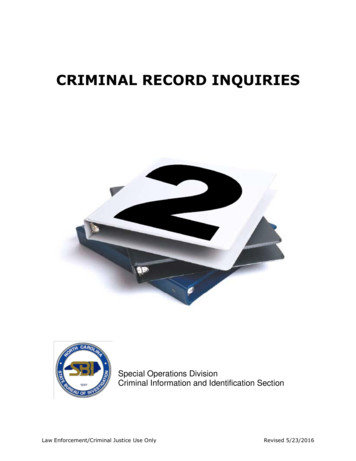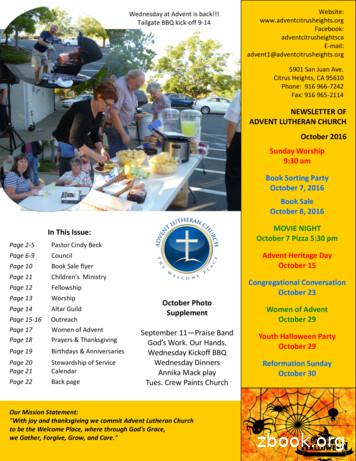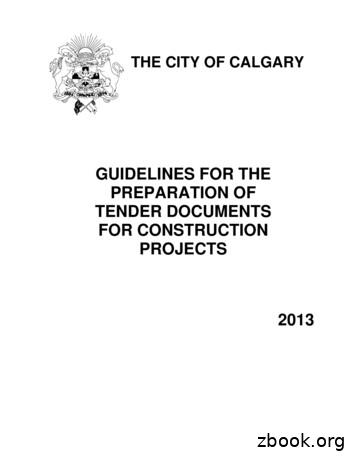Approved October 11, 2013 Revised April 23, 2014 Revised .
1Approved October 11, 2013Revised April 23, 2014Revised April 14, 2017AST Guidelines for Best Practices on the Perioperative Role and Dutiesof the Surgical Technologist During Robotic Surgical ProceduresIntroductionThe following Guidelines for Best Practices were researched and authored by the AST Educationand Professional Standards Committee, and are AST approved.AST developed the guidelines to support healthcare delivery organizations (HDO) reinforce bestpractices in the role and duties of the surgical technologist during robotic surgical procedures asrelated to the role and duties of the Certified Surgical Technologist (CST ), the credentialconferred by the National Board of Surgical Technology and Surgical Assisting. The purpose ofthe guidelines is to provide information OR supervisors, risk management, and surgical teammembers can use in the development and implementation of policies and procedures for the roleand duties of the CST during robotic surgical procedures in the surgery department. Theguidelines are presented with the understanding that it is the responsibility of the HDO todevelop, approve, and establish policies and procedures for the surgery department regarding therole and duties of the CST during robotic surgical procedures practices per HDO protocols.RationaleRobotic surgery is defined as a surgical procedure or technology that adds a computer-assistedelectromechanical device to the interaction between the surgeon and the patient.6 Examplesinclude micromanipulators, remotely-controlled endoscopes, and console-manipulated devices.6These devices enhance the surgeon’s vision, tissue manipulation, and tissue-sensing which alterthe traditional surgeon-surgical wound direct contact. Robotic surgery devices have developedwell beyond the investigational stage and their use in the OR has become an accepted method forperforming minimally invasive surgery (MIS) in most surgical specialties on a routine basis.Small healthcare to large research facilities are purchasing surgical robots and training theirsurgical personnel in the use of the robots. The surgical robot continues to evolve indevelopment (first generation surgical robots had two manipulators (arms) and the currentgeneration has four; henceforth, the layman term “arms” will be used throughout the document),and surgical applications; additionally, in anticipation that they become more economical topurchase their usage is anticipated to continue to increase. The most well-known robotic systemis the da Vinci ; the most recent generations are the da Vinci S HD, da Vinci Si, and da Vinci Xithat are hi-definition, 3-dimensional vision systems that consist of the patient cart, surgeonsconsole with foot pedals, and vision cart that contains the camera, focus controller, light source,electrosurgical unit, and equipment.1, 15 Additionally, specially designed EndoWrist instruments that provide a full range of motion and precision are used by the surgeon.
2This demands the CST to have the technical knowledge to assist the surgeon in providing qualitysurgery that ensures the safety of the patient.Approach to Organization of GuidelineAs compared to other AST Guidelines, this guideline has a different approach regarding formatand wording. The guidelines are placed under the general headings of Preoperative,Intraoperative, and Postoperative to sequence of the role and duties fulfilled by the CST.Additionally, the guidelines focus more on the “process”, meaning the specific “actions” theCST performs during robotic surgical procedures. For example, the CST is now “handing”surgical instruments to the robotic arm and assisting with specific actions such as insertion of aninstrument into a port.10 Essentially, it is no different from when the surgeon is across from theCST during non-robotic surgical procedures; the exception being, obviously, the surgeon is nowat the surgeon’s console manipulating the extension of his/her own arms which is the roboticarms, and the CST must have the knowledge as related to the technicalities of the robotic device.Therefore, based upon inquiries received at AST by surgeons, CSTs, and OR supervisorsregarding what is the role and duties of the CST during robotic surgery, this guideline includesspecific process-based information. For the duration of the guideline the technical informationwill focus on the current generation of da Vinci models.Evidence-based Research and Key TermsThe research of articles, letters, nonrandomized trials, and randomized prospective studies isconducted using the Cochrane Database of Systematic Reviews and MEDLINE , the U.S.National Library of Medicine database of indexed citations and abstracts to medical andhealthcare journal articles.The key terms used for the research of the guidelines include: robotics; robotic surgery;da Vinci robotic system. Key terms used in the guidelines are italicized and included in theglossary.Guideline IThe CST should complete training specific to the robotic device being used at the HDO.1. As with any technology used in the OR, the completion of training by the CST is necessary inorder to achieve competence with the robotic technology and surgical procedures.A. As a graduate of an accredited surgical technology program, the CST gained entry-levelknowledge of robotic surgery.(1) The initial formal education on robotic surgery is primarily through didactic studies.2a. The surgical technology student should be familiar with the medical terminologyspecific to robotic surgery, e.g. degree of freedom or rotation, articulated,manipulators, telesurgery, and carry this knowledge into the OR as a CSTpractitioner. Knowledge of medical terminology contributes to the competencyof the CST by being able to communicate with the other team members using thecommon robotic “language”, as well as an understanding of the roboticcomponents and instrumentation.(2) There may be instances where the surgical technology student may have exposure torobotic surgery during surgical rotation; however, it depends upon if the HDO has arobot, and if the student is allowed to observe and/or scrub-in on robotic procedures.
3B. Prior to participating in robotic surgery, the CST should complete specific preclinicaltraining for each type of robotic device utilized at the HCF.(1) Due to the complexity of robotic devices, robotic surgery demands the CST tocomplete didactic and hands-on training that is provided by the device manufacturerand the HDO including ongoing continuing education.2, 3a. The HDO is responsible for setting the training and competency requirements forthe equipment used on patients.11(2) When the HDO purchases a new robotic device including the accessories andinstruments, or any new item for the currently used surgical robot the CST shouldcomplete continuing education provided by the device manufacturer.3(3) The training should initially be observation and familiarization that progresses tohands-on training in a lab/simulated practice to allow the CST to learn the technicalskills as well as the ability to efficiently work with the surgical team managingunforeseen situations including trouble-shooting equipment malfunctions or patientemergencies such as internal hemorrhaging.14(4) The training should include the following (this list is not all inclusive):a. Preferably, the HDO has a dedicated OR for robotic surgery where the systemcomponents are permanently maintained. If not, training should involve propertransportation of the surgeon console, patient cart, and vision cart to the OR thatprevents damage to the components.b. How to connect the robot system components.c. Proper setup, draping, and positioning arms.d. Proper technique for white balance and calibration of endoscope and camera.e. Proper technique for inspecting robotic instruments for functionality and defects.f. Proper technique for placing the instruments in the robotic arms and exchange ofinstruments.g. Proper technique for inserting instruments into trocars as directed by the surgeon.9h. Proper technique for removal, exchange, cleaning and re-introduction of theendoscope.i. Proper technique for manipulating/moving the uterus for visualization as directedby the surgeon. (S. Walsh, personal communication, July 21, 2012).j. Proper technique for grasping and inserting the Endo Catch or Endobag .k. Proper techniques regarding how to safely and quickly move the systemcomponents in a patient emergency such as internal hemorrhaging.l. Trouble-shooting technical problems, e.g. if the device suddenly stops working orshuts down, arms make independent movements that are potentially unsafe to thepatient.m. Assisting with wound closure.n. Proper cleaning, disinfection and sterilization of reusable instruments, accessoriesand endoscopes used with the robotic device.o. Specific variations for each procedure setup.(5) A HDO should ensure that 3-4 teams consisting of a surgeon, CST, and RN are trainedto establish a continuity of patient care.5
4(6) The Robotics Team Leader (see Standard of Practice II) should document all trainingand confirm the competencies of the CST. See Appendix A for a sample competencychecklist.a. The Robotics Team Leader is responsible for documenting the training completedby CST employees including visual confirmation of the competencies of the CSTswho are a member of the robotic team.b. The Robotics Team Leader should document additional continuing education theCST employees complete regarding robotic surgery to include training on newrobotic components, instrumentation, and accessories the HDO purchased, andsurgical procedures.2. Upon completion of training and gaining experience working with the team on roboticsurgical procedures, the CST can contribute to the training of other surgical staff members.Guideline IIIt is recommended that the HDO designate an individual in the surgery department as theRobotics Team Leader.1. The Robotics Team Leader should be an individual that has extensive robotic surgicalexperience who serves as the coordinator of the robotic services program in the surgerydepartment.12A. The CST, with training and experience, can serve as the Robotics Team Leader.(1) It is recommended the HDO appoint a Robotics Team Leader when the HDO isestablishing a new robotics surgical program who can serve as the lead person incoordinating all aspects of the program including scheduling robotic procedures;purchasing new and replacement accessories and instruments; confirm availability ofaccessories and instruments for robotic procedures; provides and/or arranges trainingand continuing education.12 See Appendix B for a comprehensive list ofrecommended responsibilities.(2) The Team Leader should be an active member of the robotic team participating inrobotic procedures who can be relied upon to provide expert guidance, suggestionsand recommendations to the team during the procedure.Guideline IIIThe surgery department should review the policies and procedures (P&P) regardingrobotic surgery on an annual basis.1. The surgery department should include members of the surgical team and administrationwhen reviewing the P&Ps, including CSTs, surgeons, RNs, risk management, and infectioncontrol officer.A. The surgery department should document when the P&Ps were reviewed, revisioncompleted, and who participated in the review process.2. CSTs should be familiar with the P&Ps for robotic surgery. The orientation of newemployees should include reviewing the P&Ps.
5Preoperative GuidelinesGuideline IVThe CST must have a thorough understanding of the two robotic components, the patientand vision carts, to be able to participate in setting up the components when scrubbed in oras an assistant circulator.1. The following are brief descriptions of the patient and vision carts that the CST is involvedwith moving, setting up, and draping; the CST is referred to the Intuitive, Inc. publicationsfor detailed information. The following information applies to the S HD, Si, and Xi da Vincimodels.A. The patient cart contains the camera and instrument arms, and touchscreen monitor.(1) The S HD, Si, and Xi systems have a camera arm and three numbered instrumentarms.(2) Each arm is equipped with a clutch button that assists with all movements of the armsas well as insertion and withdrawal of instruments. To activate the clutch, the CSTdepresses the button and the arm can be moved; if the button is not depressed, theCST will meet with resistance and the arm will return to its original position.7a. There is a clutch button exclusive to the camera and instrument arms located atthe top of each arm used to adjust the final positioning of the arm during thedocking procedure as well as to insert and withdraw the endoscope andinstruments.(3) The are several accessory items that must be sterile that are positioned when drapingeach arm; the items are:a. Camera sterile adapterb. Camera arm sterile adapterc. Instrument arm sterile adapterd. Camera trocar mounte. Instrument arm sterile adapter – this has a limited use life and only reused 50timesf. Instrument arm sterile adapter – can only be used once(4) The touchscreen monitor is coordinated with the surgeon console; it displays thesystem status icons and text messages for the CST and circulator to view.1 Themonitor can also be mounted on the vision cart.7(5) The patient cart is moved with the use of a motor drive that provides for easilydocking the cart to the OR table and trocars.(6) The connections for cables are located on the back of the cart.B. The vision cart contains the light source, camera focus controller and storage bin, andvideo processing equipment; additionally, a telemonitor may be placed on the cart.15(1) For the S HD system, the light source is a sterile bifurcated cable that is attached tothe endoscope to illuminate the right and left channels; the Si system uses a singlelight source cable.7(2) The endoscope is connected to the camera head and the camera head is alsoconnected to an automa
Approved October 11, 2013 . Revised April 23, 2014 . Revised April 14, 2017 . Small healthcare to large research facilities are purchasing surgical robots and training their surgical personnel in the use of the robots. The surgical robot continues to evolve in . robot, and if the student is allowed to observe and/or scrub-in on robotic .
Student Training Manual/Workbook . 5 Law Enforcement/Criminal Justice Use Only Revised 5/23/2016 Revised By: Revised Date: Revised By: Revised Date: Revised By: Revised Date: Revised By: Revised Date: Revised By: Revised Date: Revised By: Revised Date: Revised By: Revised Date: Marie Jernigan Supervisor Training Unit SBI Criminal Information and Identification Section May 23, 2016 Jeannie .
Standard Hill North Mannville Sands Pool. Revised PO. Standard Hill West McLaren Sand Pool. Revised PO. Storthoaks Tilston Beds Pool. Revised PO. Verendrye Viking Sand Pool. Revised PO. Wauchope Central Tilston Beds Pool. Revised PO. White Bear Tilston-Souris Valley Beds Pool. Revised PO. Workman Frobisher Beds Pool. Revised PB.
location and survey section survey automation survey feature code guide book prepared by huntington hodges, p.l.s. location & survey assistant administrator december 1, 1999 revised february 1, 2002 revised january 1, 2005 revised october 1, 2005 revised january 3, 2006 revised december 1, 2008 revised january 30, 2009 revised december 1, 2010
Sunday Worship 9:30 am Book Sorting Party October 7, 2016 Book Sale October 8, 2016 MOVIE NIGHT October 7 Pizza 5:30 pm Advent Heritage Day October 15 Congregational Conversation October 23 Women of Advent October 29 Youth Halloween Party October 29 Reformation Sunday October 30 Our Mission Statement:
3.5 09 (e) Form of Tender (Yellow Sheet) Revised 3.5.13 Prime Contractor Management Status Revised 3.5.14 (a) Bid Bond Revised 3.5.15 (a) Consent of Surety to Furnish Bonding Revised 3.5.17 Waiver Form Revised 4.1 Closing and Awarding of Tenders Revised 4.1 (c ) Closing of Tenders, Evaluation and Award Recommendation Revised
Revised reprint January 1998 Revised reprint October 2001 Revised reprint June 2003 Revised reprint March 2006 Revised reprint June 2007 Revised reprint June 2008 . Chapter II—The Executive Government 18 Chapter III—The Judicature 20 Chapter IV—Finance and Trade 22
Volume 29, Issue 21 Virginia Register of Regulations June 17, 2013 2526 PUBLICATION SCHEDULE AND DEADLINES June 2013 through June 2014 Volume: Issue Material Submitted By Noon* Will Be Published On 29:21 May 29, 2013 June 17, 2013 29:22 June 12, 2013 July 1, 2013 29:23 June 26, 2013 July 15, 2013 29:24 July 10, 2013 July 29, 2013
mastery of it : writing . In a recent survey, academic staff at the University identified the interrelated skills of essay-writing and reasoning as the two most important skills for success in higher education; when asked which skills students most often lacked, essay-writing was again at the top of their list. Needless to say, writing ability is also highly prized by employers. The purpose of .























